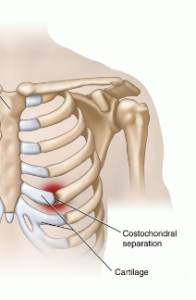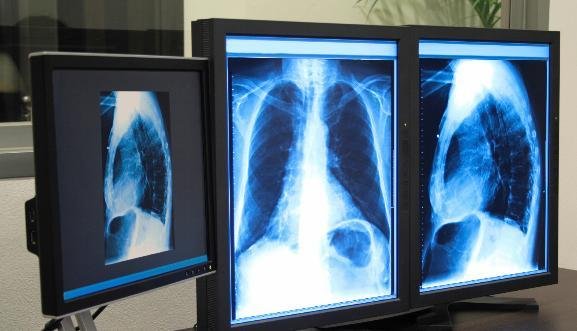What is Dislocated Rib?
A dislocated rib is one sort of injury we’re not too adept to suffer in the typical course of incidents, as we approach our day by day undertakings. All things considered, our ribs are solidly held set up by ligament, sockets, and the intercostal muscles.
Dislocated rib can be brought about by a few elements going from a simple cough to extreme events when the rib cage or general chest zone interacts with an exceptional blunt force, sudden movement or twist. Rib dislocations are not uncommon yet to the impression of the overall population. Rib injuries, for example, dislocation or rib separation happen when the rib head and abutting bones get disconnected from the sternum or spinal cord, this is additionally alluded to as rib separation. It can transpire to anyone old, youthful, pregnant moms, babies … similarly as long you are a person equipped for body movements.

Pain under the rib enclosure is one of the traditional indications of a displaced rib! Regardless of whether you’re encountering pain under left or pain under right rib, it’s best to get it looked at by an ensured specialist keeping in mind the end goal to preclude a conceivable rib harm.
Symptoms
Strong, cutting agony in the chest with each movement of the rib cage area: Patients with a rib harm as a rule encounter strong, stabbing pain in the chest, first at the time of injury and after that for a more extended period a short time later. On account of smaller injuries, rib agony can be insignificant, empowering further exercises. In more serious injuries, the patient can encounter severe, incapacitating pain in the rib confine and an inability to proceed with any injuries.
Strong pain will be experienced amid injuries and later will change into throbbing pain that can transform into concentrated injuring agony if patient tries to move too much.

The patient will encounter trouble to breathe in more profound as this causes moment sharp pain: The patient can be not able take full breaths as this causes moment sharp pain, full breaths are generally connected with an extraordinary and sharp rib pain.
The patient will likewise encounter pain amid sneezing, coughing, or more serious chest development, for example, lifting weights, twisting around, pulling or pushing.
Causes
As the chest cavity is a bigger part of the body, it is in a bleeding edge position and is prone to injuries. Amid these circumstances, when a man gets injured, ribs are first on the “strike” and these are circumstances when dislocations and cracks can happen. More youthful people don’t experience the ill effects of cracked, dislocation or broken ribs in the front or back as much as more mature people on the grounds that more youthful ribs are more flexible, while because of an absence of ligament and the nearness of senior osteoporosis, elderly’s ribs are a great deal more prone to injuries.
A portion of the reasons for rib dislocation may include:
- Sneezing
- Old age
- Coughing
- automobile mischances – auto, bicycle and so forth.
- costochondritis
- Blunt compel injury to the chest divider
- Lifting overwhelming weight at home or at the exercise center
Since the middle part of the chest is the most forward situated, cracked ribs, for example, a displaced rib crack, happen all the more regularly to medium ribs, and slightest on account of the upper three ribs that are as it were “covered up” behind the collar bone. localization of the fracture is most viewed on the frontal and back bend and brought about either by immediate or aberrant drive. With regards to dislocated, bring down ribs are most inclined to such circumstances, and furthermore either because of immediate or circuitous drive.

Rib injuries as a rule occur because of an instant injury, which is normal in games, for example, football, rugby, skiing, hockey, and so forth. Rib injuries are additionally common in car crashes and because of a fall from height.
Diagnosis
Objective examination
A dislocated rib is diagnosed by touch (palpation) on the area of the injury. The doctor will feel unevenness on the surface of the ribs, the patient will express feeling strong agony, (for example, twisted rib pain) trailed by breaking (crepitation) and movement of the displaced rib head under more concentrated weight.

Radiology diagnosis
A speculated misaligned rib will most dependably be determined by radiography of the chest pit in a few headings, a ultrasound examination or PC geology.
It is not generally simple to recognize a dislocated from a separated rib, yet it is critical to diagnose appropriately to keep any complications of these injuries as they can prompt to more severe wounds with serious consequences.

A radiology diagnosis will likewise bar other conceivable injuries that could be associated with a dislocated or cracked rib.
Treatment
Displaced rib and general rib injuries like rib subluxation, dislocation and out of place rib head for the most part have no unique treatment (unless it’s an extreme instance of rib injury), minor rib injuries like rib head subluxation or dislocated floating rib can heal all alone without any doctor`s intervention.
The most importantly medical aid is utilizing a cold compress– apply a pack of pea or ice, or solidified meat (fundamentally any solidified thing would do) specifically on where there was a popped rib, this diminishes the pain and swelling.
Recouping from a dislocation of the rib
Patients with a rib injury/ dislocated rib for the most part totally recuperate within 4 to a month and a half or longer for a situation of a more severe damage or injury, the recuperation time could draw out for a while.
By presenting certain recuperation treatment and activities a dislocated rib recuperation time can be incredibly reduced.
Such therapy and treatment may incorporate
- PRP therapy
- Special knead
- Special practice to focus on the affected area
- Yoga
Coming back to additionally demanding physical exercises is possible soon (contingent upon the earnestness of the injury), if the patient applies protective measures to prevent repeating the injury or worsening of the present illness.
References
- Hyde, Thomas E., and Marianne S. Gengenbach. Conservative management of sports injuries. Sudbury, Mass: Jones and Bartlett Publishers, 2007. Print.
- Moore, Keith L., Arthur F. Dalley, and A. M. R. Agur. Clinically oriented anatomy. Philadelphia: Wolters Kluwer Health/Lippincott Williams & Wilkins, 2014. Print.
- Premkumar, Kalyani. The massage connection anatomy & physiology. Baltimore, MD: Lippincott Williams & Wilkins, 2004. Print.
- Simons, David G., Janet G. Travell, and Lois S. Simons. Travell & Simons’ myofascial pain and dysfunction : the trigger point manual. Baltimore: Williams & Wilkins, 1999. Print.
- Walter, Andrea A., Marty L. Rutledge, and Christopher N. Edgar. First responder handbook : fire service edition. Clifton Park, NY: Thomson/Delmar Learning, 2003. Print.
- Gupta, Arun K., Veena Chowdhury, and Niranjan Khandelwal. Diagnostic radiology. New Delhi: Jaypee Brothers Medical Publishers, 2011. Print.
- Scott, Pamela M. Cases in clinical medicine. Sudbury, Mass: Jones & Bartlett Learning, 2012. Print.
- Sperber, Miriam. Radiologic Diagnosis of Chest Disease. London: Springer London, 2001. Print.
- Waldman, Steven D. Physical Diagnosis of Pain : an Atlas of Signs and Symptoms. City: Elsevier Health Sciences, 2015. Print.

So is it possible that a twisting motion with impact to the front of the upper chest cavity could push a couple ribs in the back along the spine to partially come out of the sheath and move backwards? The two displaced ribs in the back then create a torque on the rib cage causing it to twist in the front. If the ribs in the back are not sliding properly in the sheath but rather are pushed back. and trying to push on the ribs to move them back into place has been ineffective, what can be done?
.